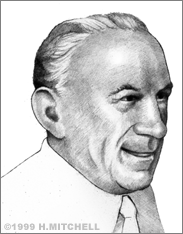Al Gross
The nonpareil pioneer of wireless telecommunications is Al Gross. In 1938, he invented the walkie-talkie. In 1948, he pioneered Citizens’ Band (CB) radio. In 1949, he invented the telephone pager. His other inventions include the basics of cordless and cellular telephony.
Gross was born in Toronto in 1918 but grew up in Cleveland, Ohio. He discovered his lifelong enthusiasm for radio on a steamboat trip on Lake Erie at age 9, after the ship’s radio operator let him listen to the wireless radio. By age 12, Gross had turned his basement into a radio headquarters, with equipment patched together from junkyards. At age 16, he obtained his amateur radio license, which is still in effect today.
Gross’ interest and ability had increased by the time he entered the Bachelor of Science program in electrical engineering at Cleveland’s Case School of Applied Sciences (now part of Case Western Reserve University) in 1936. Determined to exploit the unexplored frequencies above 100 MHz, Gross set about inventing a mobile, lightweight, handheld two-way radio. Within two years, Gross had invented and patented the “walkie-talkie” (1938).
At that time, the communications group of the U.S. Office of Strategic Services (OSS) was eager to develop a portable, two-way, air-to-ground communications system. The OSS recruited Gross, who worked for them throughout World War II. By 1941, Gross designed both a ground unit, “Joan,” and an airborne unit, “Eleanor,” which communicated with each other via Hertzian radio waves in a manner virtually impossible to monitor, even behind enemy lines.
The units had an effective range of about 30 miles. The transceiver of the ground unit weighed only 3 1/2 pounds, with a collapsible antenna, and was powered by two B and two D batteries. It could easily be carried and hidden by a soldier on hostile ground. The airborne unit, carried most often in British “Mosquito” bombers, was more complicated, heavier, and fitted with an adjustable, external antenna to transmit and receive at pre-arranged polarization. Although Gross’ top secret system was not declassified until 1976, the U.S. Joint Chiefs of Staff have called it one of the most successful wireless intelligence-gathering methods ever employed.
After the war, the Federal Communications Commission (FCC), which had become aware of Gross’ work, allocated the first frequencies for personal radio service, the Citizens Radio Service Frequency Band (1946). Gross formed a company, Citizens Radio Corporation, to produce two-way radios for personal use. In 1948, his company’s equipment was the first to receive FCC approval for use in the new “Citizens’ Band.” Gross sold about 100,000 units himself, most of them to farmers and to the U.S. Coast Guard. He also licensed the technology to various electronics companies.
In 1949, Gross made another breakthrough. He adapted his two-way radios for cordless remote telephonic signaling. That is, he invented and patented the telephone pager, by building discriminating circuitry into a pocket-sized wireless receiver that responded selectively to specific signals. Gross intended for his invention to be used by doctors, and so he attended a medical convention in Philadelphia that year. Nearly all of those healthcare professionals worried that the device would upset their patients or even interrupt their golf games. However, New York’s Jewish Hospital did implement Gross’ pager system the next year (1950).
In the 1950s, Gross tried – again, in vain – to interest U.S. telephone companies in his inventions and ideas for mobile telephony. Bell Telephone was not interested, and other companies were afraid of Bell’s monopoly on transmission lines. The FCC, to which Gross had demonstrated his pager system in 1950, finally approved his transceivers in 1958.
Gross continued to invent, earning a total of 12 patents, throughout the 1950s and 1960s. Eventually, he began working for large corporations, such as Sperry and General Electric, as a specialist in microwave and other electronic communications systems. In 1990, he became Senior Staff Engineer at Orbital Sciences Corp.’s Chandler, Arizona facility, where he directed analysis of various electromagnetic elements of aerospace, satellite, and military systems.
Besides working full-time, Gross also pursued personal projects. But his greatest enthusiasm was for the presentations that he frequently gave to local elementary and high school students on technology and invention. Thus, as Gross put it, “People learn from the old guy who did it the hard way.”
Gross was too far ahead of his time to cash in on his inventions. His patents expired long before the public was ready for CB radio, cell phones, and pagers. But his love of the work outweighed any regrets. He always smiled when he said, “If I still had the patents on my inventions, Bill Gates would have to stand aside for me.”
On the other hand, Al Gross was rich in honors and awards. He had commendations from the U.S. Defense Department (1969) and President Reagan (1981) with about a dozen awards from national organizations like the Institute of Electrical and Electronics Engineers (IEEE). Gross also won the 2000 Lemelson-MIT Lifetime Achievement Award and was honored at the Lemelson-MIT Awards Ceremony, held at the American Museum of Natural History in New York on April 27, 2000. He died that same year on December 21, at the age of 82.


